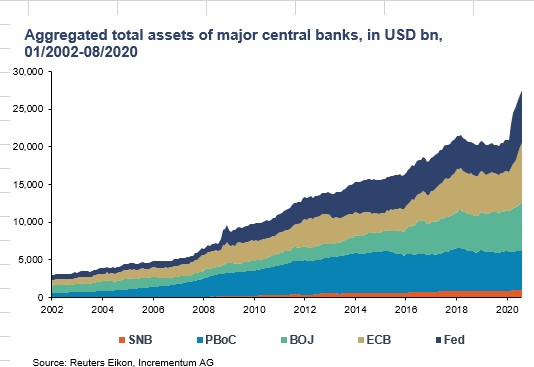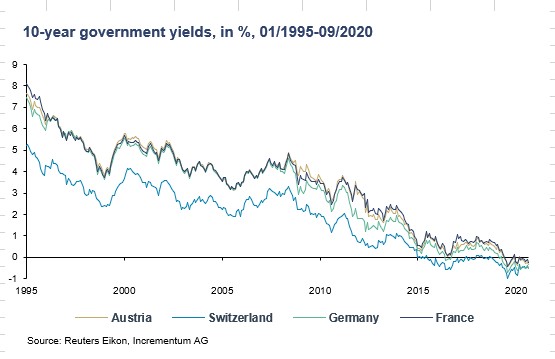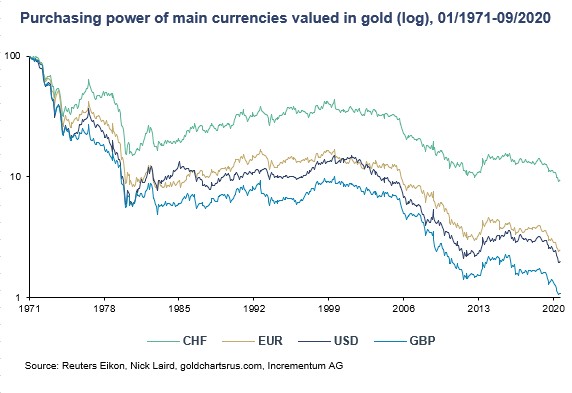Crowds, like sheep, are only as safe as the shepherds who guide them.
If the shepherd is mad, so too is the crowd.
Today, central bank shepherds are leading the vast majority of investors over a currency cliff. This is easy to predict, despite the fact that most forecasting models are woefully flawed.
THE FAILURE OF PREDICTIVE MODELS
Whatever one’s views of the recent Presidential election in the U.S., for example, we can all agree that the professional pollsters and their advanced algorithms got the “blue wave” of an easy Democratic landslide completely, well…
Wrong.
Whether predicting viral death rates, political elections, GDP growth, budgets, tax revenues or market direction, the experts and their analytics have been consistently poor in mapping out the near future.
The World Bank, for example, is projecting global GDP to increase in 2021 by 4%, despite the obvious damage COVID lockdowns have already done to global economies.
That same World Bank has also confessed to a global debt tally of $260 trillion. This means global debt to GDP is now greater than 3:1, which makes such growth projections openly comical.
THE FANTASY OF CENTRAL BANK MESSAGING
As for central banks who print money out of thin air to buy unwanted sovereign debts, they too are projecting miraculous solutions to otherwise staggering debt problems based on, you guessed it: Creating more debt.
And how will this debt be paid? Easy—with money created by a mouse click at a central bank near you.
Seem a little bit too good to be true for the economic future?
Well, the U.S. Fed’s track record for forecasting recessions is 0 in 10, but that has never stopped them from making inaccurate and contradictory projections which resemble a kind of open madness:
“You will never see another financial crisis in your lifetime.”
-Janet Yellen, spring 2018
“I do worry that we could have another financial crisis. ″
-Janet Yellen, fall 2018
“There’s no reason to think this (bullish) cycle can’t continue for quite some time, effectively indefinitely.”
-Jerome Powell –2018
“The US is on an unsustainable fiscal path; there’s no hiding from it.”
-Jerome Powell–2019
In the post-08 “new abnormal” of deficits without tears and embarrassing new theories which argue that unlimited money creation can never lead to inflation, the fantasy forecasters have been quite busy replacing reason with madness.
PREDICTING THE END?
But can economies, as well as near-term price actions in markets, truly be forecasted with results better than a coin toss?
My answer is a clear “yes” and a clear “no.”
Why?
Because some things, like the complex movement of a Swiss watch can in fact be trusted, and hence predicted; while other phenomena, like the madness of crowds and their preference for fantasy, cannot.
TRUST CAN NOT BE FORECASTED
The vast majority of investors, for example, have an almost blind faith in central banks housed in impressive buildings with fancy folks running them.
Measuring that faith, as well as the inevitable loss of that faith, is harder than a Rolex repair. In fact, it’s impossible to time, even when objective evidence suggests that the experts are indulging in madness.
Since 2009, central banks and policy makers have done nothing but put lipstick on an economic pig by using artificial money to buy unwanted IOU’s and then telegraphing the result as “free market capitalism,” or even worse, a “recovery.”
To ignore such madness in favor of blind faith is itself a kind of madness, and madness, like COVID-19, spreads best in crowds.
Today, the vast majority of the world has gone financially mad, and most don’t even know it.
SOME MARKET FORCES CAN BE FORECASTED
Informed investors, as well as students of history, math and common sense, however, have long since stood outside of the crowd.
They accept that market laws, like laws of physics, are in fact quite predictive.
For example, not once in the history of nations, markets or exchanges, has any empire, system or market ever successfully prevented an economic, currency or market collapse by printing gobs and gobs of fake money.
Not once. Not ever.
The Austrian school of economics, unlike Keynesian debt madness taken too far, long ago understood that an economic party sustained by debt ends with a brutal hangover caused by that same debt.
Just as physicists long ago understood that for every action there is an equal and opposite reaction (F=MA), Austrian economists like von Mises similarly understood that market forces are no different.
For every debt rise there is an equal and opposite debt fall.
Given that today’s global economy is supported exclusively by the greatest debt levels ever recorded in the history of capital markets, should we not therefore be confident in “forecasting” one helluva a day of reckoning for our global markets, economies and currencies?
Or as von Mises so bluntly warned:
“There is no means of avoiding the final collapse of a boom brought about by credit expansion. The alternative is only whether the crisis should come sooner as the result of voluntary abandonment of further credit expansion, or later as a final and total catastrophe of the currency system involved.”
The short answer, then is yes, some things are foreseeable. 1+1 still equals 2, and debt-based “recoveries” always fail, along with their inflated currencies.
Despite such cold facts, the current fantasy being pushed by the MMT crowd as well as politicians and central bankers from Japan to the U.S., is that such economic reckonings (including inflation) can be outlawed by a money printer.
Folks: That’s madness in a nutshell.
Such short-term fantasy explains how economies right outside your front door are tanking while stock markets (enjoying artificial, low-rate debt rollovers) in the U.S. and elsewhere are approaching new highs.
Those highs are quantifiably correlated to global money printing like this:

Printed, fiat currencies are used to push bond prices so high that bond yields (which move inversely to price) have been so thoroughly distorted that for the first time in market history, we are seeing negative yielding bonds across the globe like this:

That too is, well…Madness.
Such objective charts are staggering, and ought to be a universal wake-up call to any sane observer of global markets.
Again, to believe otherwise, frankly, smacks of a kind of madness.
But as Mark Twain warned, crowds often prefer a comforting fantasy over a hard fact, and are thus easy to fool.
Hence, economic policy makers continue to lead a crowd of sheep over a cliff of unsustainable debt paid for with diluted currencies that destroys their hard-earned wealth.
The inherent purchasing power of all major currencies are now tanking by the second when compared against timeless measurements of value like gold.
The following graph is perhaps the most important one you will ever see:

In short, global currencies are among the first dominos to fall in an artificial global economy sustained by grotesque levels of debt paid for by equally grotesque levels of fiat money creation.
Inevitably, economies and markets fall in succession with their currencies. The historical cure for such currency madness is a gold, which far from being a “barbarous relic” of the past, is a timeless solution for the future.
Again: This is predictable. This is forecastable.
To consider such evidence yet burry one’s head is a form of madness. To ignore the evidence, or worse yet, hide or downplay the evidence, is even more maddening.
Most “financial journalists,” for example, studied marketing rather than markets and are hardly reliable “warning bells.”
They understand click-bait techniques and key words, and get their research from a Google search rather than a basic understanding of economic forces.
Not 1 in 10 of average investors (or 1 in 100 of average “financial journalists”) have ever paused to consider simple charts like those above.
That, alas, explains the spread of fantasy as well as the madness of crowds who feel their currencies, stocks, and bonds are in the safe hands of the experts.
Folks, those experts are paper tigers, not financial lions. For now, however, mad faith in their mad policies continues.
TIMING THE IMPOSSIBLE, PREPARING FOR THE INEVITABLE
But for how long?
Timing human emotion, blind faith or even collective madness is a fool’s errand.
The emotional element of the global economy is too complex for easy modeling, and right now, the vast majority of market participants still trust the “experts” in general and the central banks in particular, to save them.
Comforting speeches from the FOMC and empty headlines from the sell-side on the latest tech stock have replaced basic economics, math and history.
Stated more simply: Fantasy has replaced facts.
Neither I nor you can time the expiration date of this misguided yet ephemeral trust in using counterfeit money to pay for record-breaking debt levels and historically unmatched asset bubbles.
But as both history and natural market forces confirm, that trust ends once currencies lose their value and the madness of crowd faith in fantasy is replaced by a mad crowd of broke investors.
Those who confront facts rather than fantasy, however, can prepare for the unfolding of history and math without having to worry about the precise “timing” of what is otherwise inevitable.
Toward that end, the historical remedy for the current wave of policy madness has always been the same: Precious Metals.
Original source: Matterhorn - GoldSwitzerland
Reproduction, in whole or in part, is authorized as long as it includes all the text hyperlinks and a link back to the original source.
The information contained in this article is for information purposes only and does not constitute investment advice or a recommendation to buy or sell.

















